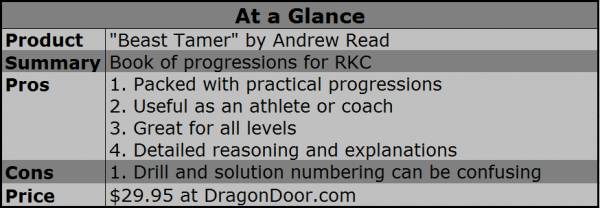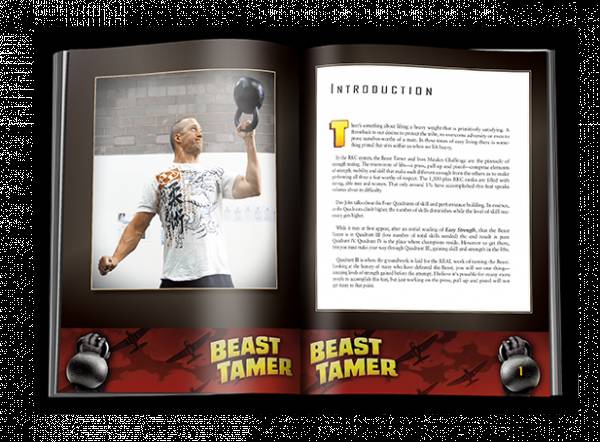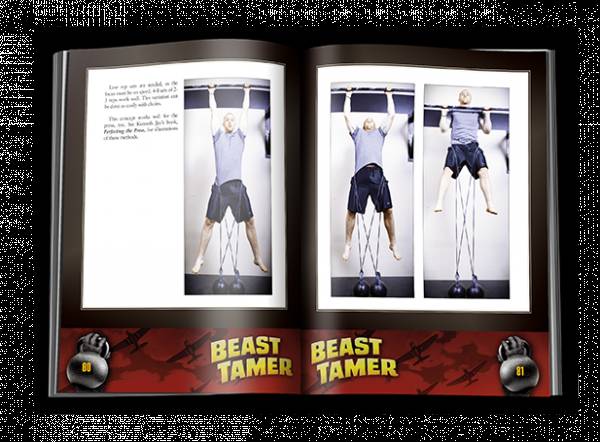
Andrew Read, Master RKC, is a great writer when it comes to articles on strength and performance. So when I was asked to review his new book, Beast Tamer, I was interested and excited to see if he could translate that same passion and wisdom into a book.
The book is based on becoming a Beast Tamer, which involves performing a perfect pistol, a press, and a pull up with a 48kg kettlebell. This is perhaps the ultimate strength testing accolade in the Dragon Door RKC kettlebell instructor training system. The equivalent for women is becoming an Iron Maiden by performing the same with a 24kg kettlebell. Make no mistake, this is a tough challenge involving a combination of strength, mobility, and skill across three very different movements. As Andrew notes, only one percent of those involved in the RKC system have ever achieved it.

Andrew is faced with a challenge himself here – breaking down an elite challenge into an achievable system and accessible format. In summary, he manages this very well.
The book begins by explaining the challenge, and this introduction sets the tone for the rest of the book. Andrew always takes it back to the real core of whatever he is writing about, and in the introduction, he begins by explaining why you should be lifting heavy stuff in the first place. He follows this up by referring to a variety of well-respected strength training figures, including Dan John, Mel Siff, and Yuri Verkhoshansky, citing their strength training beliefs as a basis for this book. These solid foundations help to give the book credibility straight away.
Andrew then introduces some themes that run throughout the book. For one, he explains that a key to mastering this challenge is identifying and working your weaknesses. Throughout the book, he continues to remind us of similar basic strength training principles that would serve us all well, such as hard work, perseverance, patience, and discipline. I like the way this book has a final goal – to tame the Beast – but also puts great value on the journey.
The book is then split into three sections for the pistol, the press, and the pull up. These sections start with drills required to develop skill, which is good for those who need basic skill progressions for the movements. However, Andrew is mindful throughout the book of the different skill (and strength) levels of his audience and explains how for more advanced trainers these same drills can be used as a warm up. Additionally, within each section there are good explanations of why Andrew focuses on particular drills, their benefits, and their carryover.
At the end of each section, Andrew includes two different specialist programs for the pistol, the press and the pull up. The pistol section also contains a light version if all you want to do is learn the pistol. The press section is structured well, and includes details on position, mechanics, and common faults.
This section is also a good example of how Andrew always takes the reader right back to basics. For the press, this includes how to create good and tight rack position. To accomplish this, Andrew reverts back to something as simple, yet undervalued, as plank drills. I feel that this type of information is invaluable even if you are not that concerned with the challenge itself. The pull up section follows a similar vein as the previous two sections, providing valuable strategies for building the upper back strength required to meet the challenge.

The book then incorporates some workout plans. These are not just a list of workouts as in many books, but are explained well in terms of goals and how you would use the plans. Within these workouts, and the book in general, Andrew references many other books and authors such as Dan John and Pavel Tsatsouline. I like the respect paid to these coaches and the fact that the book does not try to reinvent the wheel – rather, it is a synthesis of strength training concepts mixed in and pulled together through Andrew’s deep experience and expertise.
Finally, there are some interviews with those few that have completed the challenge. Even these are filled with tips and tricks – yet more value for your money.
My only criticism at this point has nothing to do with the writing or information. Rather, it is that there’s so much practical information packed into the book, with drill and solutions all numbered and mixed in with each other, that sometimes it serves to flick back a few pages to remind yourself of the overall goal of the drills and solutions offered.
The book is written in an honest and personal fashion. Andrew is happy to say that he hates certain drills because they are difficult, or to explain when something works even though he has no specific scientific backing for it.
This book is absolutely packed with practical information, corrective fixes, and drills. The programming is personalized as much as possibly can be within a single book. The lessons are valuable regardless of the specific aspect of strength training you are interested in. Whether you are an athlete or a coach, this book is well worth a space on any strength enthusiast’s bookshelf.
“Beast Tamer” is available for $29.95 at DragonDoor.com.






